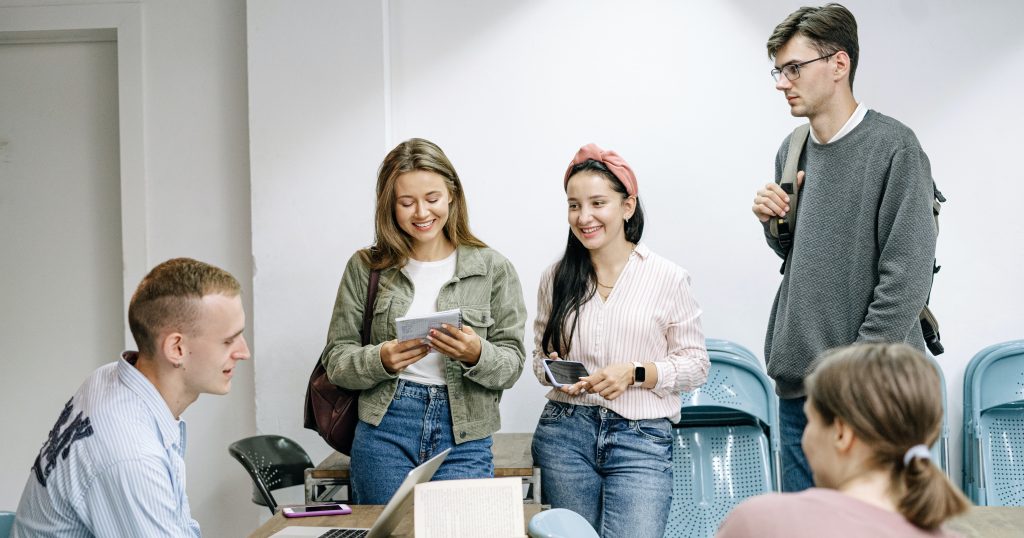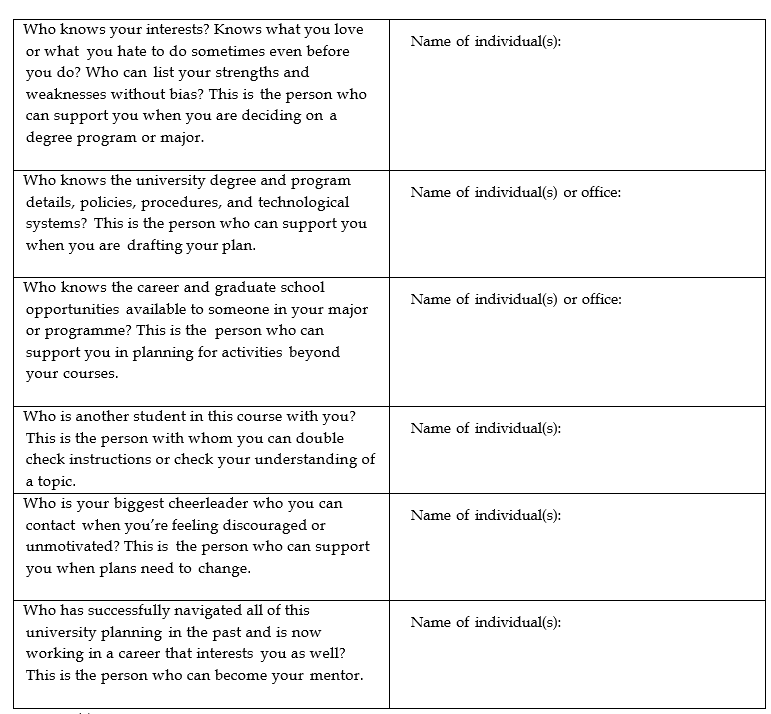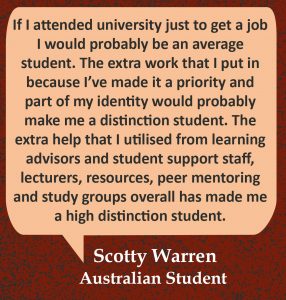1.3: Successful Connections
- Last updated
- Save as PDF
- Page ID
- 146809

- Bianca Retallick, Debi Howarth, Leigh Pickstone, & Sam Conway
- University of Southern Queensland

Introduction
University can be intimidating. Thousands of unknown faces, cryptic messages emblazoned on PowerPoints and an unending list of acronyms that can be confusing and confronting. One way to ensure you don’t get lost in the jungle is to make successful connections to the support services offered at university. This chapter begins by discussing the importance of asking for help at university, and then helps you to create your own support contact list. Next, it considers the types of varied support staff and peers you can access, followed by a look at the inclusivity of all students at universities, especially those with a disability. The chapter concludes by explaining the value of reaching out for support to maintain your mental health while studying.
Asking for Help

At university, there are many individuals and support services who can help you plan your path. Students grapple with unfamiliar university paperwork and technology with little assistance as they proudly tackle perhaps newfound roles as adult decision-makers. Seeking help is a strength, not a weakness, particularly when that help comes from well-informed individuals who have your best interests in mind. When you share your goals and include others in your planning, you develop both a support network and a system of personal accountability. Being held accountable for your goals means that others are also tracking your progress and are interested in seeing you succeed. When you are working towards a goal and sticking to a plan, it’s important to have unconditional cheerleaders in your life as well as people who keep pushing you to stay on track, especially if they see you stray. Knowing who in your life can play these supportive roles will allow you the opportunity to confidently immerse yourself in the university experience.
Your Support Contact List
When you start a new job, go to a new school, or even fill out paperwork at a new doctor’s office, you’re often asked to provide contact information for someone who can assist in making decisions and look out for your best interests in the event of an emergency. Academic decision-making and planning doesn’t involve the same level of urgency, but it’s useful to have in mind the people in your personal life and university life who motivate and support your plans, or can assist you in setting them. Prepare your support call (text, email, or direct message) list now so that all you have to do is pick up your phone to get the support you need. Keep in mind that one person can fulfill more than one role. Use the following table as a catalogue for your support call list.
Table 3.1. Support contact list

Academic Advisors

All universities provide resources to assist you with your academic planning. Academic advisors may also be called success coaches, mentors, or counselors. They may be staff members, or faculty members who may provide advisement as an additional role to their teaching responsibilities. Regardless of what your university calls this role, academic advisors are individuals who are able to assist you in navigating the puzzle of your academic plan and piecing your courses and requirements together with your other life obligations to help you meet your goals.
An advisor is an expert on your university and its major requirements and policies, while you are the expert on your life circumstances and your ability to manage your study time and workload. It is also an advisor’s responsibility to understand the details of your degree requirements. This person can teach you how to best utilise university resources to make decisions about your academic and career path. An advisor can help you connect with other university staff and faculty who might be integral to supporting your success. Together with your advisor, you can create a semester-by-semester plan for the courses you will take and the special requirements you will need. Even if your university does not require advising, it is wise to meet with an advisor every semester to both check your progress and learn about new opportunities that might lend you a competitive advantage in entering your career. Common functions that academic advisors can help you with include:
- Setting educational and career goals
- Selecting a major and/or minor
- Understanding the requirements of your degree
- Navigating the online tools that track the progress of your degree
- Calculating your Grade Point Average (GPA) and understanding how certain choices may impact it
- Discussing your academic progress from semester to semester
- Assisting with time management strategies
- Connecting with other support and resources at the university such as counseling, tutoring, and career services
- Navigating institutional policies such as grade appeals, admission to special programs, and other concerns
- Strategising how to make important contacts with faculty or other university administrators and staff as necessary (such as discussing how to construct professional emails)
- Discussing transfer options, if applicable
- Preparing for graduate school applications
Lecturers as Learning Partners

In primary and secondary education, the teacher often has the dual role of both instructor and authority figure for students. Children come to expect their teachers to tell them what to do, how to do it, and when to do it. University learners, on the other hand, seem to work better when they begin to think of their lecturers as respected experts who are partners in their education. The change in the relationship for you as a learner accomplishes several things: it gives you ownership and decision-making ability in your own learning, and it enables you to personalise your learning experience to best fit your own needs. For the lecturer, it gives them the opportunity to help you meet your needs and expectations, rather than focusing all their time on trying to get information to you.
The way to develop learning partnerships is through direct communication with your lecturers. If there is something you do not understand or need to know more about, go directly to them. When you have ideas about how you can personalise assignments or explore areas of the subject that interest you or better fit your needs, ask them about it. Ask your lecturers for guidance and recommendations, and above all, demonstrate to them that you are taking a direct interest in your own learning. Most lecturers are thrilled when they encounter students who want to take ownership of their learning, and they will gladly become a resourceful guide for you.
Mentors
When making academic decisions and career plans, it is also useful to have a mentor. A mentor is an experienced individual who helps to guide a mentee. A good mentor for a student engaged in academic and career planning is someone knowledgeable about the student’s desired career field, is more advanced in their career than an entry-level position, or who is skilled and qualified as a Career Development Practitioner. This person models the type of values and behaviours that are essential to a successful career, and helps the student better understand their own values and strengths.
Your university may be able to connect you with a mentor through an organised mentorship program or through the alumni association. The Career Development service, available to the student body at many Australian universities, may offer Work Integrated Learning opportunities and the chance to connect with potential mentors (Hora et al., 2020). Additionally, student/staff partnership projects facilitate connection between students and potential mentors (Cook-Sather et al., 2014) Remember, you can also find a mentor by reaching out to family, friends, and contacts who work in your field of interest, and through applying for membership of professional associations and organisations related to your field.
Peers

Aside from the professional support personnel there will be opportunities to learn from more experienced students who can help you understand coursework and the university environment in a less intimidating way (Kimmins, 2013). Study groups and Peer Assisted Learning programs are offered at many Australian universities. These programs are academic support programs rather than mentoring programs, providing opportunity for students to study collaboratively with peers to improve their academic learning skills, to develop connections, and to become more comfortable with the university environment (Pascarella & Terenzini, 2005). By learning with other students, you can share the learning and study journey in your chosen discipline.
Peers as Mentors
Peer mentoring occurs through both formal and informal processes at many universities. Programs facilitated through the university often take place throughout the first few months of the academic year; participating can help you become accustomed to university life (Shaniakos, T., Penttinen, L., & Lairio, M., 2014).  Connection with a peer mentor can assist you to become part of the learning community, and to learn about the range of supports available to you (Christie, 2014).
Connection with a peer mentor can assist you to become part of the learning community, and to learn about the range of supports available to you (Christie, 2014).
Peer mentors and mentees are people of similar age and experience, who work together to strengthen social supports, to share information, to give feedback, and to nurture friendship (Terrion, J.L., & Leonard, D, 2007). Because peer mentors are similar in experience to you as a mentee, they can help smooth the way as you step into a new environment (Christie, 2014).
YARNING WITH PEERS AND MENTORS
Yarning is a form of communication valued by Aboriginal and Torres Strait Islanders. It takes the form of one person speaking and another person, or a group of people, listening. Terare and Rawsthorne (2019) describe it as “a process of storytelling that involves both sound and silence”. There are quick yarns, long yarns, funny yarns or serious yarns. Yarning can be done face to face, on the phone or online. Yarning is basically having a conversation with someone else which creates knowledge and understanding (Bessarab & Ngandu, 2010; Walker et. al., 2014).
Yarning is an effective way to communicate with your peers and mentors and to build valuable connections that can support your university journey. For example, you could yarn about the stress of adjusting to university, your concerns about money or the challenges of finding your way around the university campus or website. Yarning about your assignments and feedback from your lecturer is also a good way to clarify your understanding of university expectations. Whether it’s in a formal or informal setting, yarning is way to tell your stories and learn from the stories of others. It has also been shown to have positive impacts on health and well-being (Terare & Rawthorne, 2019).
No matter what the context, there is meaning in every yarn. Whether those stories are about your heritage or about everyday life, they all carry meaning (Phillips et. al., 2018, p. 8). Yarning is a valuable tool for connecting with others, for understanding university life and for finding meaning in the world around you.
Students with Disabilities
Students with disabilities are sometimes the most informed when it comes to making decisions about their own learning. It is in students’ best interest to make their educational institution aware of their own unique situation and to leverage available resources and opportunities. Just like anyone else, under the law, qualified students with disabilities are entitled to the same education universities provide to students without disabilities. Even though a particular disability may make attending university more difficult, awareness on the part of the government, learning institutions, and the students themselves has brought about a great deal of needed change over the years. Now, students with disabilities find that they have more appropriate student services, campus accessibility, and academic resources that can make attendance and academic success possible. Due to this increased support and advocacy, Australian universities have seen an increase of students with disabilities enrolled.
Legislation for students with disabilities
Universities are governed by state and Commonwealth legislation, in particular the Disability Discrimination Act 1992 (Cth). This legislation requires that all people should be given equal rights, equal opportunity, and equal access to many things including education. Australian universities are required to make provision for access to their facilities, online and face to face services, and academic support for all students including those who have a disability. Higher education institutions also have policies and procedures, as well as staff, to ensure the right settings and equipment are available to enable all students, including those with a disability, to demonstrate their ability and capabilities for successful study. Policy and procedure must demonstrate and promote the inclusion of all students across campuses. Each university will have a dedicated support team for students with disabilities, including those students with mental health and well-being concerns. Support staff in institutions can assist students to access all necessary support to ensure they can be included within university life and successfully complete their study.
Students will have access to reasonable adjustments for assessment and should seek assistance from disability support areas if there are problems in accessing facilities, classes, online or face to face study requirements. Fostering an inclusive community of scholars is a fundamental objective of Australian universities. If you need assistance, please contact your student disabilities and wellbeing unit who can help you with settling into university life and to know what is available to support you in your study.
Mental Health Resources

Because entering university is such a big transition, it is important to know what health services are available on your campus. Some help may be beyond the scope of a university counseling program, and if this is the case, your university health center can refer you to off-campus resources to support you. Your brain requires a constant supply of energy to function. What you eat and are exposed to have a direct impact on its processes, your mood, and your ability to make good decisions. Most university students feel anxious, lonely, or depressed at some point during the year. We all have bad days, and sometimes bad days string into weeks. It’s OK to feel bad. What’s important is to acknowledge and work through your feelings and find a friend or a counselor to talk to. Two experiences that students often encounter are stress and anxiety.
Stress
Like with any new adventure, starting to navigate university and its requirements can be stressful. Your ability to manage stress, maintain loving relationships, and rise to the demands of university and work all impact your emotional and mental health. Feeling stressed can be perfectly normal, especially during exam time. It can motivate you to focus on your work, but it can also become so overwhelming you can’t concentrate. It’s when stress is chronic (meaning you always feel stressed) that it starts to damage your body. Stress that hangs around for weeks or months affects your ability to concentrate, makes you more accident-prone, increases your risk for heart disease, can weaken your immune system, disrupts your sleep, and can cause fatigue, depression, and anxiety (University of Maryland Medical Center, n.d.).
Anxiety
We all experience the occasional feeling of anxiety, which is quite normal. Unfamiliar situations, meeting new people, driving in traffic, and public speaking are just a few of the common activities that can cause people to feel anxious. It is important to seek help when these feelings become overwhelming, cause fear, or keep us from doing everyday activities. Anxiety disorders are one of the most common mental health concerns, and while there are many types of anxiety disorders, they all have one thing in common: “persistent, excessive fear or worry in situations that are not threatening” (National Alliance on Mental Illness, n.d.). Physically, your heart may race, and you may experience shortness of breath, nausea, or intense fatigue. Talk with a mental health care professional if you experience a level of anxiety that keeps you from your regular daily activities. Taking care of your mental health is incredibly important, especially when you find yourself in a new environment such as a university. Knowing what you are feeling and how to get help if you need it is imperative to ensuring your tertiary experience is positive and successful.
Conclusion
Navigating your way through university can at first, be difficult and confronting. As you have seen however, the way to be successful is to reach out and seek help and support when you need it.
Key points
- All universities offer a range of learning support services. These can include academic advisors, mentors and peer support services and/ or programs.
- Your lecturers can also assist you. Use clear communication to tell them what you need help with. This can lead to a positive working partnership.
- All Australian universities ensure inclusive learning opportunities for all students. Students with disabilities will have access to all learning opportunities and resources.
- Universities also offer a range of non-academic support such as counselling, which you can use for emotional or mental health support.
References
Beltman, S., Helker, K., & Fischer, S. (2019, November). ‘I really enjoy it’: Emotional Engagement of University Peer Mentors. International Journal of Emotional Education, 11(2), 50-70. Retrieved 2021, from https://www.um.edu.mt/library/oar/bi...1%282%29A4.pdf.
Bessarab, D. & Ngandu, B. (2010). Yarning about yarning as a legitimate method in indigenous research. International Journal of critical Indigenous Studies. 3(1), 37-50.
Christie, H. (2014). Peer Mentoring in higher education: issues of power and control. Teaching in Higher Education, 19(8), 955-965. Retrieved April 2021, from http://dx.doi.org/10.1080/13562517.2014.934355
Cook-Sather A., Bovill C., Felton P. (2014). Engaging Students As Partners in Learning and Teaching: A Guide for Faculty. John Wiley & Sons.
Disability Discrimination Act 1992 (Cth) (Austl.).
Hora M., Chen Z., Parrott E., Her P. (2020). Problemizing college internships: Exploring issues in access, program design and development outcomes. International Journal of Work Integrated Learning, 21(3), 235-252.
Kimmins, L. (2013). Meet-Up for success: The story of a peer let program’s journey. Journal of Peer Learning(6), 103-117.
National Alliance on Mental Illness. (n.d.). Anxiety Disorders. https://www.nami.org/NAMI/media/NAMI...sorders-FS.pdf
Pascarella, D., & Terenzini, P. (2005). How college affects students. San Francisco: Jossey-Bass.
Phillips, L., Bunda, T. & Quintero, E. (2018). Research through, with and as storying. Routledge.
Shaniakos, T., Penttinen, L., & Lairio, M. (2014). Peer Group Mentoring Programmes in Finnish Higher Education – Mentors’ Perspectives. Mentoring & Tutoring: Partnership in Learning, 22(1), 74-86. Retrieved from doi-org.ezproxy.usq.edu.au/10...67.2014.882609.
Terare, M. & Rawsthorne, M. (2019). Country is yarning to Me: Worldview, health and well-being amongst Australian First Nations People. British Journal of Social Work. 50, 944-960. https://doi.org/10.1093/bjsw/bcz072
Terrion, J.L., & Leonard, D. (2007, May 17). A Taxonomy of the characteristics of student peer mentors in higher education: findings from a literature review. Mentoring & Tutoring: Partnership in Learning, 15(2), 149-164. Retrieved April 2021, from https://doi-org.ezproxy.usq.edu.au/1...11260601086311.
University of Maryland Medical Center. (n.d). University of Maryland Medical Cente. https://www.umms.org/ummc
Walker, M., Fredericks, B., Mills, K. & Anderson, D. (2014). Yarning as a method for community based health research with Indigenous women: The Indigenous Women’s Wellness Research Program. Health Care for Women International, 35(10), 1216-1226.

